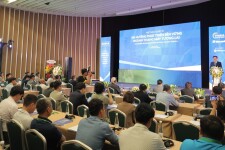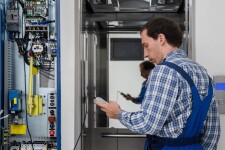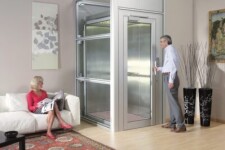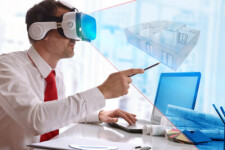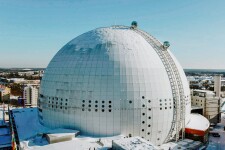With 4 layers of modern protection, the elevator ensures user safety and helps to avoid dangers from bacteria and viruses, detects and warns people about fainting or stroke inside the cabin.
Public buildings and high-rise apartment buildings need elevators, but today, elevators have gradually become indispensable for private houses, adjacent villas, townhouses, etc. Besides aesthetics and utility, safety features are still the top concern in elevators.

For the first time in Vietnam, the elevator has appeared 4-layer protective technology, raising user protection to a more proactive level. Elevator innovation integrates many technologies to bring the most comfort to users, not just to ensure safety.
This layer is the primary protective commonly applied in elevators on the market today. It includes the following safety features:
Rescue bell to warn for rescue when there is a problem with the elevator.
Telephone for internal communication (Intercom)
Automatic Rescue Device (ARD). In the event of a power failure, the automatic rescue unit will use the backup power to bring the elevator to the nearest floor so that the user can exit.
In addition, the elevators can also be equipped with overload alarms, infrared lights to detect obstacles, prevent the elevator from moving when there are obstacles such as passengers’ hands, feet, clothes,
The above features have met the safety of elevator users, and we can also say that these features are the first level of rescue for an elevator.
In addition to the above features, since 2017, several high-end elevator companies have researched and released the Self Rescue System (SRS). When there is a power failure and the ARD automatic rescue unit fails, you need to press the red button on the screen. The elevator will automatically move to the nearest floor and open the door for users to step outside. This feature helps you feel secure and proactive when traveling by elevator.
Emcall communication system. This system works as follows: When something goes wrong, users need to press the yellow button on the control panel, the elevator will automatically activate, making calls to 5 preset phone numbers in the sequence (the number of the technicians and family members) until the phone is connected.
In addition, the Emcall system also reports errors to the control center, helping technicians understand the situation, detect and handle errors in a timely manner. This feature can be considered the 3rd layer of rescue in the elevator, preventing tragic incidents and preventing passengers from panicking when locked inside the elevator.
Not only protecting users from dangerous situations such as power failure, elevator traps, currently, elevators are also innovated and developed to new steps, warning users from other dangers. This feature is thanks to the Stroke Warning System (SWS) that is automatically activated when someone trapped in the cabin loses consciousness (stroke, fainting, …). SWS will send a message to the service center of the elevator installation and maintenance unit for the timely rescue.
This feature is helpful if the user loses consciousness and cannot perform any action to escape or call for help. Thus, the elevator plays the role of a supervisor, proactively detecting and promptly notifying support users.
In addition, to protect health from bacteria and viruses, you can refer to some technologies such as:
These technologies form a layer of protection in different ways and situations, which is also a solution for families when there is no one to look after and protect elders and children in the house. However, for installation advice, you should seek the advice of experts and architects, who are knowledgeable and ready to give the most helpful advice to users.
In Vietnam today, 4-layer protection technology has been deployed and installed. In addition to the above technologies, you can learn and choose other features such as cabin ventilation fan using Plasmacluster technology, Stroke warning system (SWS), Smart entry system (SES), Flood Detection System (FDS), Smart Lighting System (SLS),…
